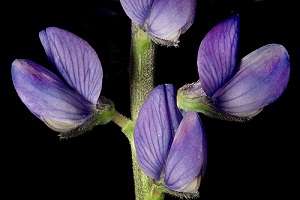Lupin prospects improve with pinpointed disease causation

The cause of a disease affecting the local lupin industry has been discovered in PhD research at UWA's Institute of Agriculture.
Black Pod Syndrome (BPS) is a severe necrotic disease of lupin pods which causes large crop losses and prevents many WA farmers from growing lupin, especially in the south-west coastal area of the state.
BPS causes the pods on lupin plants to turn dark brown or black and halts or reduces seed production.
UWA PhD researcher Monica Kehoe says the study has been able to cement suspicions that researchers have had on the cause of BPS.
"The most important result of the research is the confirmation that late infection with Bean yellow mosaic virus [BYMV] is the cause of BPS in narrow-leafed lupins," Ms Kehoe says.
BYMV is mostly found in high rainfall wheatbelt zones and is endemic in south-western Australia.
The virus can infect clover plants next to pastures of lupin and is spread by aphids. It is especially difficult to control as it can survive from one growing season to the next in the infected clover.
Ms Kehoe says her research – which involved PCR and ELISA testing of lupin in five locations, and greenhouse cultivar studies – shows the timing of infection of the virus plays a large part in causing BPS.
"If the BYMV infection occurs before the primary pods are forming, the plant will turn fully necrotic and die as we would expect with a typical early BYMV infection," she says.
"Infection after the primary pods have developed leads to symptoms of BPS ... and yields are greatly reduced."
Now that the cause has been found Ms Kehoe says farmers can more confidently plan prevention strategies to stop BPS from causing major losses.
"Ultimately a variety of narrow-leafed lupin with resistance to BPS is the goal," Ms Kehoe says.
"The lupin breeding team at DAFWA [Department of Agriculture and Food] screens huge numbers of accessions each year for a number of molecular markers that have already been located for various other traits including disease resistances.
"So finding a molecular marker for BPS that can be incorporated into that process is the next logical step."
There is currently one variety of lupin that exhibits partial resistance to BPS and Ms Kehoe says resistance is something that DAFWA researchers are looking at.
Provided by Science Network WA





















